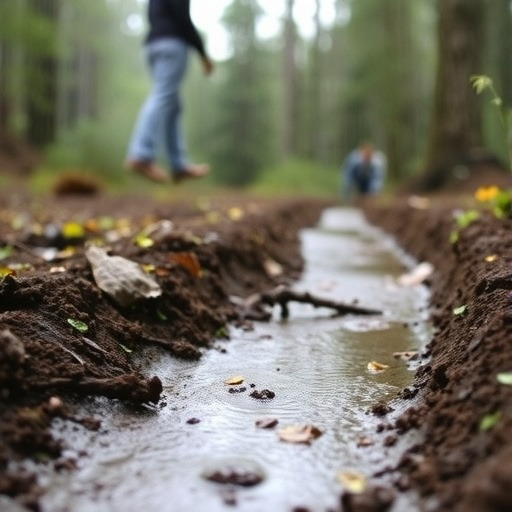In recent years, the intricate relationship between soil moisture and precipitation has garnered increasing attention from scientists aiming to unravel the complex feedback mechanisms that govern Earth’s climate system. A groundbreaking study published by Sun, Yang, He, and colleagues in Nature Communications has made significant strides in deciphering the causal pathways that connect soil moisture dynamics to global precipitation patterns. This work not only advances our understanding of land-atmosphere interactions but also holds promising implications for improving weather forecasts and climate modeling.
At the heart of this investigation lies the concept of soil moisture-precipitation coupling. Soil moisture, the amount of water contained within the soil, influences evaporation rates and consequently the atmospheric moisture content. This, in turn, affects cloud formation and precipitation. The feedback loops between soil moisture and precipitation are nonlinear and vary spatially and temporally, posing a considerable challenge for researchers attempting to quantify their strength and directionality across diverse ecosystems.
The study leverages a sophisticated statistical framework built upon causal inference techniques, which enables the disentanglement of complex cause-and-effect relationships in environmental systems. By integrating global observational datasets with advanced computational modeling, the authors isolated the direct impacts of soil moisture on subsequent precipitation events, effectively separating them from confounding factors such as temperature fluctuations, atmospheric circulation, and anthropogenic influences. This methodological innovation represents a significant leap forward in climate science, where distinguishing correlation from causation has traditionally been fraught with uncertainty.
One of the most striking findings of this research involves the identification of distinct regional patterns in soil moisture-precipitation coupling strength and directionality. For example, in arid and semi-arid regions, positive feedback loops dominate, where increased soil moisture enhances local humidity and precipitation, creating a reinforcing cycle. Conversely, in humid tropical forests, the coupling tends to be weaker and sometimes even negative, due to already high baseline moisture levels and complex canopy interception effects.
Beyond regional heterogeneities, the study also reveals temporal dynamics in the coupling mechanism. Seasonal variations markedly affect the causal influence of soil moisture on precipitation. During the wet season, saturated soils contribute to elevated evaporation rates, strengthening the coupling, whereas in dry seasons, soil moisture depletion dampens this effect. These insights provide a nuanced understanding of how climate anomalies such as droughts and floods may propagate and intensify through land-atmosphere feedbacks.
Moreover, the authors explored the implications of these causal pathways under future climate scenarios. Using climate models that factor in increased greenhouse gas concentrations, they projected potential shifts in the soil moisture-precipitation coupling across various biomes. The results suggest that changing temperature and precipitation regimes might alter the feedback loops, potentially amplifying drought risks in vulnerable regions and complicating water resource management.
This research carries substantial importance for atmospheric scientists and meteorologists striving to enhance the fidelity of precipitation forecasts. Incorporating the dynamic soil moisture-precipitation interactions into predictive models can reduce uncertainties in weather predictions, particularly for extreme events such as flash floods and prolonged dry spells. Such improvements could significantly benefit agriculture, disaster preparedness, and water management sectors worldwide.
The study’s methodology also underscores the transformative potential of employing causal inference in environmental science. Traditional correlation-based approaches have long plagued climate studies with ambiguous interpretations, but by adopting frameworks such as convergent cross-mapping and Granger causality analysis, the authors successfully circumvented these issues. This approach paves the way for new research avenues focused on elucidating causal mechanisms in other complex Earth system processes.
Critically, this work highlights the indispensable role of interdisciplinary collaborations in tackling multifaceted climate problems. The integration of data science, physics, hydrology, and ecology was essential to unravel the soil moisture-precipitation nexus comprehensively. This approach exemplifies the future trajectory of climate research, which must synthesize diverse scientific perspectives and innovative methodologies to address planetary-scale challenges.
Furthermore, the findings shed light on how land management practices might influence climate feedbacks. Since soil moisture is sensitive to vegetation cover, soil texture, and land use, human interventions such as deforestation, irrigation, and urbanization could modulate local precipitation regimes. Recognizing these causal pathways equips policymakers and land managers with critical knowledge to design climate-resilient strategies that optimize ecosystem services and minimize unintended climatic disruptions.
Importantly, the research also touches upon the potential bidirectional nature of the soil moisture-precipitation relationship. While soil moisture influences precipitation patterns, precipitation itself replenishes soil moisture, creating a tightly coupled system with potential hysteresis effects. Understanding this bidirectionality is crucial for interpreting climate variability and constructing feedback-aware climate models that can capture emergent phenomena effectively.
The global scope of the analysis is particularly noteworthy. Previous studies often focused on localized regions due to data and computational limitations. By harnessing state-of-the-art remote sensing technologies, the authors analyzed soil moisture and precipitation interactions spanning continents and oceans. This planetary-scale perspective is vital for generating holistic insights and informing global climate policy frameworks.
Lastly, the study emphasizes the urgency of advancing observational capabilities to monitor soil moisture more accurately. Satellite missions equipped with microwave sensing technologies, along with ground-based measurement networks, are indispensable assets that complement model-based approaches. Improving observational resolutions and coverage will enhance the precision of causal inference analyses and enable real-time monitoring of critical land-atmosphere interactions.
In conclusion, Sun and colleagues’ pioneering work elucidates the causal pathways underpinning the global coupling of soil moisture and precipitation with unprecedented clarity. By bridging statistical innovation with environmental science, this research marks a monumental step toward decoding Earth’s complex climate feedbacks. Its findings hold transformative potential for meteorological forecasting, climate modeling, and sustainable land management, rendering it a milestone contribution to the science of climate dynamics.
Subject of Research: The study focuses on discovering the causal mechanisms that link global soil moisture variability to precipitation patterns, exploring how these interactions vary regionally and seasonally and forecasting their responses to climate change.
Article Title: Causal pathways underlying global soil moisture–precipitation coupling.
Article References:
Sun, J., Yang, K., He, X. et al. Causal pathways underlying global soil moisture–precipitation coupling. Nat Commun 16, 8935 (2025). https://doi.org/10.1038/s41467-025-63999-7
Image Credits: AI Generated




